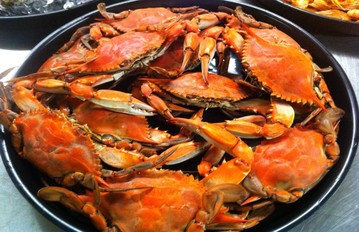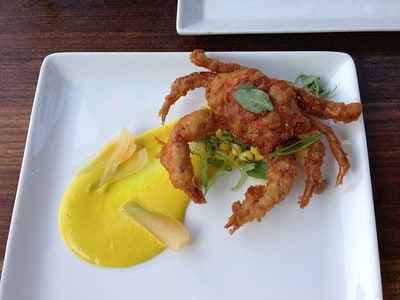Why do Shellfish Turn Red After They’re Cooked?
Every summer my friends and family have a crab feast. Crabs go in the steamer with brilliant blue claws and olive green shells, then come out bright red.
I’ve always been curious as to why crabs, lobster, shrimp, and all shellfish turn red after they’re cooked. So, I sat down and did some research.
Why do shellfish turn red after they’re cooked? Shellfish turn red because their shells contain a carotenoid pigment called astaxanthin. The cooking process exposes the red pigment found in astaxanthin, turning shellfish bright red after being cooked.
I don’t know about you, but I need an explanation in plain English. Let’s go over why shellfish turn orange after being thrown in the steamer.
Explaining the Phenomenon
Let’s use crabs, my favorite shellfish, as an example- blue crabs particularly.
Crabs, like most shellfish, belong to an animal family called crustaceans. This group of animals does not have bones, but instead, have hard shells called exoskeletons that grow on the outside the body.
These shells do exactly what the bones in the human body do for us. They form the crab’s shape and protect its internal organs, such as its gills, intestines, and so on.
These shells are usually green, blue, and brown, but more on that later.
Have you ever seen a crab before it has been cooked? An uncooked Blue Crab has brilliant blue claws with an olive green shell. After it’s cooked, it all turns into a delicious bright red. Where did that color come from?
The reason for the color change is because the chemicals inside of the crab’s shell react to the heat. Please note that this applies to all shellfish
We mentioned earlier that the crab’s shell contains a red pigment called astaxanthin that naturally appears red. This same organic pigment, or carotenoid, turns carrots orange or salmon pink.
I also mentioned earlier that crab shells, and most shellfish for that matter, naturally have a brown, olive-blue, gray, or muddy color.
We know that the shell contains a red pigment, so where is it?
Fun fact: Flamingos are pink because they eat prawns, a type of shellfish. The crustacyanin protein dissolves inside the acids and fats in the flamingo’s stomach, turning its feathers pinkish.
Well, it’s actually right in front of you! And it covers the whole shell, even when it looks like a muddy brown. The color of a shellfish’s shell is received from a protein complex called crustacyain. It’s basically a couple of strands of proteins which determine the crustacean’s outer color.
In its natural, uncooked form, crustacyain absorbs blue light. This makes our eyes see the outer shell as an olive-blue (on blue crabs at least).
Crustacyain is bound to the red pigment astaxanthin, but it’s been twisted to show an olive-blue or muddy brown that we see in uncooked crustaceans.
When the protein complex (crustacyain) is heated, it untwists removing its blue-ish brown appearance and fully exposes the red color of astaxanthin.
It’s not astaxanthin that changes in heat, the protein complex crustacyain does. Throwing the crab’s in a boiling pot of water just unravels the proteins to show off the red astaxanthin, resulting in a red shell.
This is exactly what happens when you cook crabs, lobsters, even shrimp!
Congratulations, you now have something to talk about at your next crab feast to make you sound very intelligent.
Why Do Shellfish Contain Astaxanthin?
But why contain astaxanthin in the first place? Would it change anything if the crab didn’t have the chemical, and stayed a muddy brown after being cooked?
For starters, let’s talk about why crustaceans are naturally a distasteful muddy blueish-brown.
You may already know that crustaceans are bottom feeders- they live on the ocean floor and scrounge for food. The protein complex actually works as a huge advantage for crabs. It gives them, and all crustaceans, and color that blends in perfectly to the sea bottom. This will protect them from predators such as birds or large fish.
But this doesn’t explain why it has astaxanthin. Couldn’t the crab just live without the red pigment?
It isn’t known exactly at the moment why crabs have this carotenoid (astaxanthin). We know for a fact that it originates in algae.
It’s theorized that it discourages barnacles and other parasitic organisms from attaching themselves to crabs, or other shellfish.
If this is so, astaxanthin is the big reason why we can eat crabs, lobsters, and most other shellfish. Without it, parasitic organisms would attach itself to the poor creatures making them inedible. The more you know!
Every once in awhile, fishermen will find a crab or a lobster that leaves the pot the same color it went in: a grayish-white color.
It’s estimated that that 1 in 100 million lobsters is albino. This means they do not have any pigments in their shell and end up on your dinner table a ghostly white.
Related Questions
Why do shellfish have to be cooked alive?
Crabs and other shellfish live in very unclean environments which leads to harmful bacteria living in their shells. While they do not affect the crab or its meat while it’s alive, it can spread rapidly once it dies. Cooking shellfish while they are alive removes the change of any harmful bacteria spreading to its meat.
What color are lobsters in the ocean?
Lobsters have a variety of colors across the world. Lobsters in North America tend to have a dark brown, almost gray color, while lobsters in Europe can be blue!




